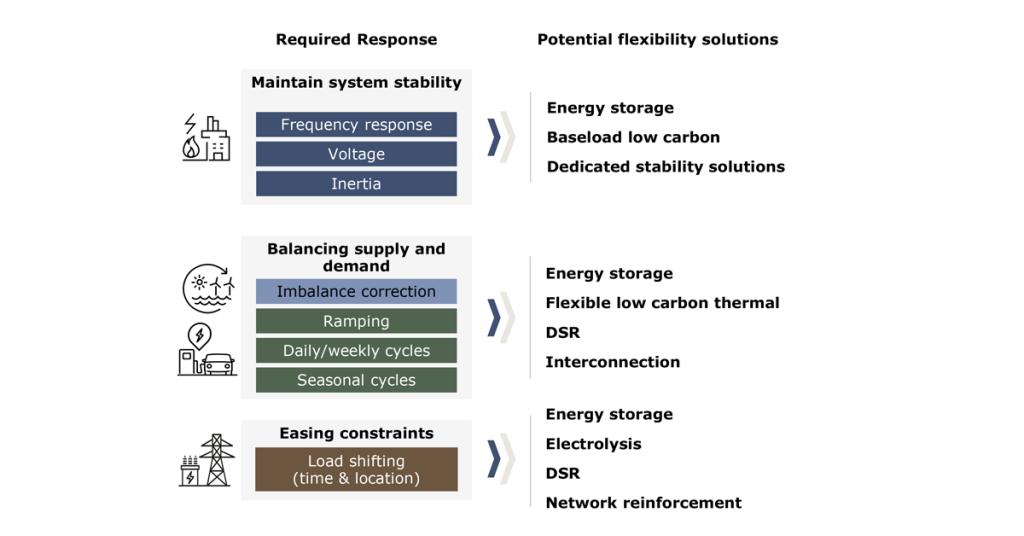
Why the definition of long duration storage is important
John Perkins explores the importance of categorising long duration storage technologies while looking at what is required to meet future system needs.
In 2022, the UK government department BEIS (now DESNZ) published their response to a call for evidence in relation to “Facilitating the deployment of large-scale and long duration electricity storage”. As part of this consultation, DESNZ put forward a definition for long duration energy storage as “storage technologies that can store and discharge energy over 4 hours and have a power capacity of at least 100 MW”. In response to this consultation, most respondents broadly agreed with this definition.
However, it is not clear to us that this is the right definition. The wider context here is that DESNZ have signalled that they are going to intervene in the market to de-risk investment in long duration storage. From a range of different support options, the front runner for a support mechanism to incentivise investment in storage appears to be a cap and floor scheme. This has various advantages, not least that Ofgem is already comfortable with such a scheme for interconnection. Under such a scheme, the storage asset would likely need to demonstrate a positive business case and ability to deliver consumer benefits.
Clarity of storage definitions are necessary so that the right services are procured
Any assessment of the eligibility of projects for cap and floor needs to account for the benefits that these projects may deliver for consumers. It will be necessary to accurately weigh the utility of a given technology across a wide range of different flexibility services, and also to assess the relative benefits of very diverse storage technologies. Any such process needs to be very clear about exactly what services are going to be needed in a net zero power system.
Whilst ancillary services will be a function of energy storage, AFRY consider that energy balancing at different timescales (nationally and locationally) will be the chief role that storage has to play in the future.
Exhibit 1 – Technology options for addressing the system flexibility requirements
A range of flexibility services will be required from new providers in order to deliver a net zero power system by 2035. Storage is likely to be needed to contribute to all of these services.

As currently defined, a long duration storage support mechanism is likely to attract technologies as diverse as, on the one hand, 6 hour novel chemical storage focussed on similar value propositions to those of 4 hour li-ion batteries today and on the other, 168 hour (1 week) mechanical storage with a very different role to play in the energy system.
It remains to be seen if it is possible to construct a mechanism that fairly compares the range of services assets can provide. It is also a significant challenge whether you can always compare across technologies providing the same service.
A weakness with the current definition is that it obscures the need to ensure that storage capable of providing certain services is brought forwards. AFRY’s perspective is that having good definitions of different categories of storage helps to clarify where there are stronger needs in the system.
Any future support mechanism for LDES should be designed as such that it delivers the various energy balancing services that the power system needs most. This is something that will evolve over time as well.
Exhibit 2 – GB residual demand gaps in 2050: (i) the frequency of generation deficits for given ranges of hours and (ii) the average TWh of generation gaps during these hour ranges (AFRY Central scenario)
A wind-dominated net zero system is characterised by infrequent periods of renewable generation deficits, but these periods will require TWh scale storage in order to maintain security of supply

Exhibit 2 illustrates that by 2050, a range of storage durations will be required. This will include short duration storage that can integrate the daily fluctuations in wind and solar output. But it will also include multi-week storage, that can ensure security of supply during extended wind lulls. Of course, other durations will still have a role to play in the low wind periods, but the scale of the generation gaps will tend to lead to a need for ultra-long duration storage options. In the short term, these extended wind lulls will continue to drive a need for unabated gas generation, but by 2050 a wider range of storage durations are likely to be required.
Clarity of storage definitions are necessary so that the right support mechanisms are designed
AFRY believe that the current definition of long duration storage is too broad to ensure that any support mechanism delivers the kinds of storage that are most needed.
A repeated theme in our discussions with developers of storage technologies, where durations are in the range of 6-10 hours, has been how their capex compares to that of li-ion batteries. Within AFRY’s modelling, we see a clear potential for li-ion batteries to extend to 6 or even 8 hour projects within the GB market by 2050. Any other technology will need to compete with the expected cost curve for the incumbent li-ion storage costs. Another key consideration for technologies of this duration is the extent to which the demand side is expected to provide large volumes of within-day flexibility; flexibility from EVs and heat storage may lead to an erosion of value from other storage technologies seeking within-day value.
With these competitive dynamics in mind, we see a clear potential for some grid-scale storage technologies to end in a flexibility sour spot, rather than a sweet spot. This may include technologies with storage durations of 4-10 hours, that are also not sufficiently differentiated in their value proposition from li-ion batteries and DSR. By contrast, we see real value in technologies that offer an alternative to the operating patterns of unabated gas CCGTs.
We believe that it is important not only to have clear categories of storage in order to procure the right services, but also so that any support mechanism provides the kind of support that incentivises the types of storage that are needed most. A clear set of definitions of long duration storage help clarify what exactly this support mechanism is for.
It is quite likely that any storage support mechanism will also need to evolve over time. The needs of the system in 2030 are likely to be materially different from the system of 2050. In 2030, it is unlikely that a large hydrogen sector will exist, with interconnected electrolysis, storage and hydrogen turbines. The available storage technologies would be able to smooth renewable output across hours and days. However, by 2050, it is possible that hydrogen storage can emerge to provide the bulk of the flexibility required to smooth the multi-week aspects of wind generation fluctuations. Incentivising these different forms of storage may require different mechanisms, not least because hydrogen technologies may have access to different forms of support directed specifically towards hydrogen.
Conclusions
AFRY have proposed that there should be further distinctions between short, medium, long and perhaps even ultra-long duration storage technologies. AFRY’s categorisation is as follows:
- Short Duration Storage (SDS) with durations of 4 hours or lower;
- Medium Duration Storage (MDS) with durations of over 4 hours, up to 10 hours;
- Long Duration Storage (LDS) with durations of over 10 hours up to 168 hours; and
- Ultra-Long Duration Storage (ULDS) with durations of over 168 hours.
This distinction has emerged in a technology neutral context. Whilst the scenarios we have recently modelled have included a range of different specific technologies, the “winners” that have arisen in those scenarios have largely been determined by the specific modelled costs and parameters agreed. However, the focus for a support scheme should be on the flexibility services that will be required in a net zero power system. The main task for energy storage in this context will be balancing intermittent renewables over the time periods in question as presented in Exhibit 3.
Exhibit 3 – Illustrative overview of flexibility providers and system needs in 2050

Storage duration overview:
- Short duration storage will provide half-hourly balancing of wind and solar forecast error, as is already being well met by batteries.
- Medium duration storage will be required for balancing over the daily cycles of demand and solar PV. This will be competed for by batteries, established technologies such as pumped hydro, various emerging storage technologies and demand side flexibility (especially from EV smart charging).
- Long duration storage will be required for multi-day events, such as prolonged transmission constraints over low demand weekends and balancing multi-day wind events, caused by typical weather patterns that drive changes in wind output. Technologies such as compressed air energy storage (CAES), liquid air energy storage (LAES) and also pumped hydro are likely to be candidate technologies here, but there are also novel chemical storage options that can provide ~100 hour storage solutions.
- Ultra-long duration storage will be required for more extended high demand plus low wind events, since relatively rare wind droughts can last around a month. It is likely that this category is dominated by hydrogen storage.
AFRY are not overly wedded to our proposed definitions of where one category ends and another begins, but we feel that it is helpful to be clear about there being different categories of storage, as set out above. 1
Footnotes
- 1. It is also worth saying that because a certain asset may be designated as long duration storage, this doesn’t prevent it from offering the services that shorter duration storage assets also perform. For example, a long duration pumped storage hydro asset can also provide the services that a medium duration storage asset does, and also some of the services that a short duration storage asset does too. Pumped hydro is a good example here because a given asset will typically be composed of multiple turbines, and therefore there is potential to distinguish between the services that each turbine offers respectively. But the point stands for other technologies as well. ↩


